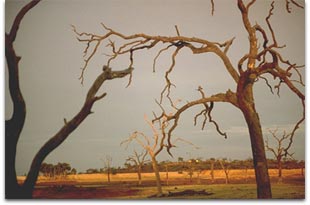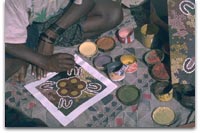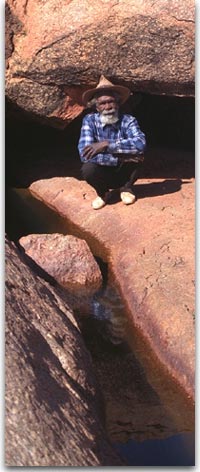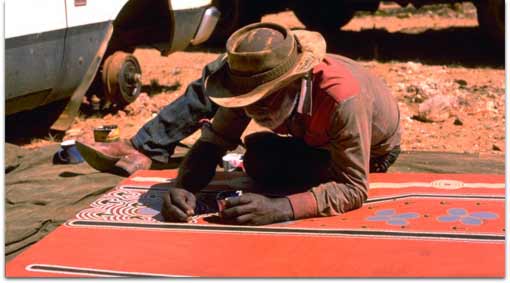 |
Mount Allan Aboriginal
Community |
 At first impression the landscape of Mount Allan is somewhat uninspiring,
with the flat terrain and the seemingly endless mulga scrub dominating
the eye. It is when the outcrops of red stone are approached that one begins
to appreciate the diversity and adaptability of the native vegetation.
Climb
onto one of these outcrops, and a stunning vista of rocky islands on
a sea of mulga is revealed. The native pines respond to the sun's golden
probes
with the most exquisite display of colour changes - green, blue and golden
- with their dark twisted trunks locked in an ancient dance against a
backdrop of rainbow pastel. At first impression the landscape of Mount Allan is somewhat uninspiring,
with the flat terrain and the seemingly endless mulga scrub dominating
the eye. It is when the outcrops of red stone are approached that one begins
to appreciate the diversity and adaptability of the native vegetation.
Climb
onto one of these outcrops, and a stunning vista of rocky islands on
a sea of mulga is revealed. The native pines respond to the sun's golden
probes
with the most exquisite display of colour changes - green, blue and golden
- with their dark twisted trunks locked in an ancient dance against a
backdrop of rainbow pastel.

The receding sun in the late afternoon reflects
off a billion facets
of stone, and the non stop display of colour changes amongst the vegetation
culminates in an awesome array of fiery red before the orb sinks below
the razor edge of blue hills, and the first twinkling star heralds
the display yet to come. From this magical desert landscape comes a wealth
of artistic
expression that is rich in ancient folklore and is unique to the rest
of
the world.
 |
Old Cassidy Japaldjardi
at Ngarlu Rockhole |
Mount Allan Station
Mount Allan Station, 300 km from Alice Springs off
the Tanami Desert Track, is an Aboriginal owned and operated cattle
station. There is a
community store providing food and fuel for travellers and for the
250 people who live on Mount Allan, and a Primary school .
The successful promotion of the art and culture of the Anmatjerre people
provides a substantial source of revenue for the painters and the community
as a whole. Whether the paintings are telling of a dreamtime act of
creation, or of food-gathering or ceremonial events, they always relate
to particular
physical sites known to the artist, of immense importance to the bonding
they feel for the rugged countryside of the Mount Allan district.
Ancient
Art - Modern Materials
Acrylic paintings have replaced the ochres,
clays and chalky pastes used for colouring in by-gone days, and canvas,
stretched on wooden
frames
has all but replaced the fleeting images told in sandpaintings.
It is for ceremonial occasions only - initiation ceremonies and corroborrees
- that traditional colouring ingredients are still used for the
creation
of the sacred, fleeting, sandpaintings. For acrylic paintings,
instead of the traditional twigs of yesteryear, the flat top of a paint
brush
is used to make the dots so prevalent in Western Desert art, but
the stories and symbolism remain the same. Circles, depicted in
rings of
dots, denote important sites such as trees, waterholes, camping
sites, or other physical features.
Curves in the paintings indicate groups of
people camping, or gathering food together, while small oval shapes
and stick-like figures denote
the tools used during food gathering. The tracks of animals feature
often in the stories, as well as body decorations worn during ceremonial
occasions.
The paintings are map-like in their depiction: i.e. there is no "top
or bottom " to the scenes they portray. Aboriginal desert art is
the newest, yet oldest, art form in the world today. Each painting is
a combination of tradition and innovation. The symbolism is both complex
and ambiguous to the uninitiated. In contemporary art terms, they are
incredibly dynamic and cosmic in their geometric abstraction.
Cultural Continuity
The increasing demand and recognition of the Aboriginal
desert art form by Western culture is helping to ensure that the skills
and the stories
survive, while at the same time helping to bridge the gap between the
two cultures. The financial reward for the art produced at Mount Allan
is an important component of the community's viability as the Aboriginal
people enter their third century of European occupation. Having no
traditional written language, the art is the means by which the dreamtime
stories
have been passed on for thousands of years. It is fitting that the
recognition for this work has never been higher, and ironic that white society's
belated interest may be the crucial ingredient necessary to keep the
dreaming alive forever.

Jack Cook Jungala
|
